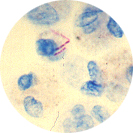|
Introduction
Case1:
Vomiting
Case 2:
Cough & fever
Case 3: Bruising
Case 4: Sore
throat
Case 5: Jaundice
Case 6: Flu & fever
Case 7: Diarrhea
Case 8: Black
Robe
Case 9: Back Pain Catching the
beast
Thanks to
Quiz
Please |
|
M. tuberculosis
causes a hypersensitivity reaction.
- M. tuberculosis is an acid fast
organism.
- It has no Gram reaction (neither + or - ).
- The organism has a wax-like coat around
it.
- The coat seems to protect the bug from the
normal means of bacterial killing our body uses.
- Also, it's this waxy coat that causes the
immune system to go wild.
- We develop a Type IV (cell
mediated) hypersensitivity, which results in tissue destruction.
|
 |
- Typically, the primary infection occurs in
the lung, and results in an area of granulomatous inflammation. This
initial lesion is known as a 'Ghon focus.'
- The spread of the infection may be
contained at this point. Locked in the granuloma.
- Granuloma formation is complex, involving
the bug, macrophages and lymphocytes.
- The result is Type IV or delayed
hypersensitvity.
- In many cases, however, this primary
focus may reactivate (even years later),
- producing what is called secondary or
endogenous tuberculosis.
- During this secondary phase, the
bug may spread widely throughout the body.
All we really had were two lumbar
vertebrae, how do we know is was TB?
Back |
|
|
